I. What are the Other Functions of the Respiratory System?
While doing our box exercises for breathing (do this before sleeping and just before you sit your exam!), we perhaps zone much into the process of breathing and may overlook some of the other roles that our respiratory system partakes in to ensure our overall health and well being!
Once we look deeper into the details, it’s amazing to appreciate how much more involved the respiratory system is in regards to maintaining our physiological well being outside of its main role in gas exchange! Let’s go ahead and see what other roles the respiratory system is involved in!
II. Roles Outside of O₂ and CO₂ Gas Exchange
Aside from its main function of bringing oxygen in and taking carbon dioxide out, the respiratory system is also involved in other aspects of physiological homeostasis such as acting as an innate immune defense as well as regulating our body temperature! Let’s go ahead and delve more into this!
A. Immune Defense Role of the Respiratory System
The function of the respiratory system as an innate immune defense is so important because it’s one of the portions of the body that’s constantly exposed to the external environment! It accomplishes this role due to the various cells and structures lining the tract!
Let’s first start with the nasal cavity: though this is where you may have an embarrassing nose hair sticking out, these nose hairs (specifically called vibrissae) are so important in respiratory defense as they’re literally the first barrier that pathogens must encounter before entering the respiratory tract.
They filter out larger respiratory particles (about > 10 microns) from entering the tract which could possibly be harboring pathogens like bacteria or viruses that can cause infection!
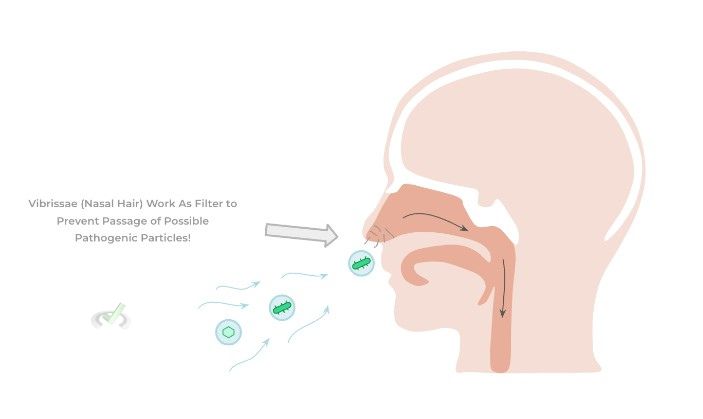
Looking at the histology of the respiratory tract, we’ll see that it’s primarily composed of ciliated pseudostratified respiratory epithelium: the most important component of the epithelium is the cilia which is an motile, extracellular organelle which is bound and extends from the cell surface.
Another important cell type associated with the respiratory epithelium is the Goblet cell which has the function of producing mucus, a very viscous, gel-like substance.
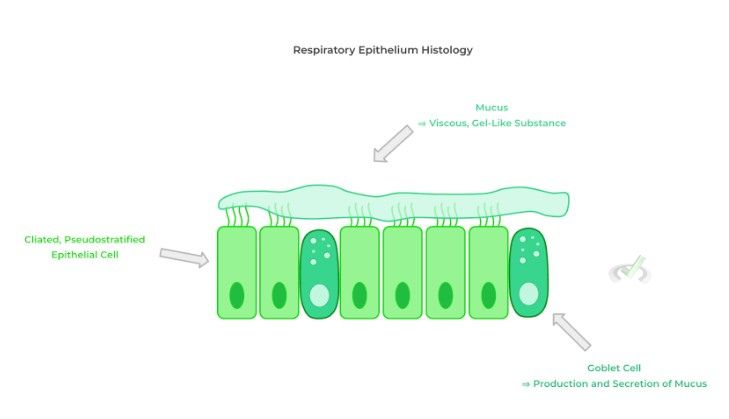
Together, the release of mucus by the Goblet cells combined with the motile movement of the cilia works in synergy to form the mucociliary elevator, which is a strategy utilized to clear pathogens which have entered deeper into the respiratory tract.
The thick, viscous nature of the mucus traps pathogens while the cilia beats in a pulsating, motile fashion in order to move mucus (with the trapped pathogens) upwards out of the respiratory tract to be expelled and coughed out!
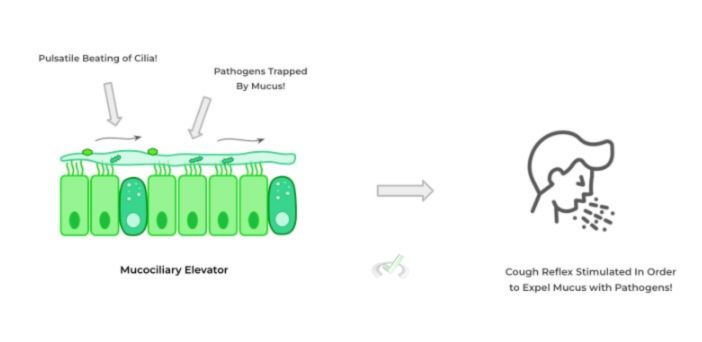
B. Thermoregulation
The respiratory system is also involved in maintaining a homeostatic balance of temperature within the body. Just like dogs pant after playing fetch, humans have the similar respiratory mechanism to also cool down — though to a much lesser extent as much of our thermoregulation is a result of sweating.
In cases of increased body temperature, we breathe in external cooler air which makes its way down the respiratory tract into the level of the alveoli. The blood flowing through the alveolar capillaries has high temperature due to the increased body temperature!
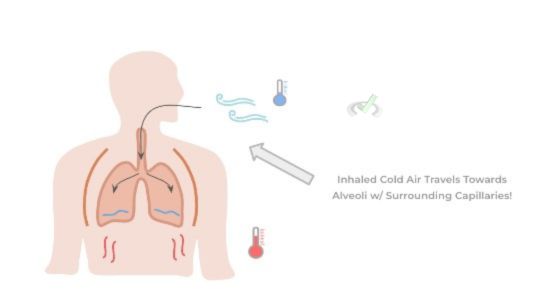
When the external cool air meets the high temperature of the blood, equilibration occurs where heat from the blood diffuses into the air within the alveoli.
Now, the alveolar air has higher temperature because it’s gained heat which has diffused from the blood, which now is lower and results in decreased body temperature — the air can then be exhaled and the cycle and be repeated.
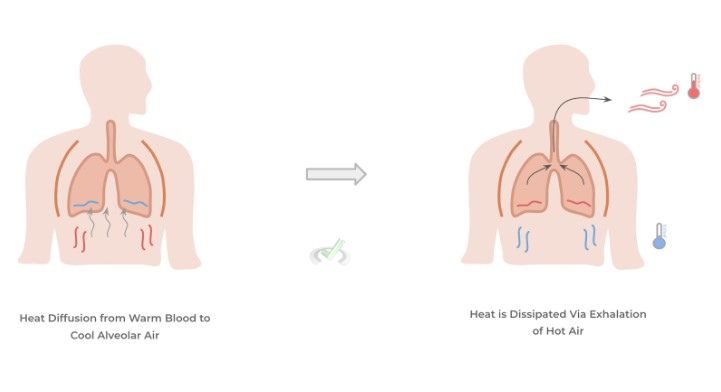
C. Regulation of Blood pH
Finally, the other main role of the respiratory system is to regulate the blood pH via changes in the ventilation rate. We have a whole detailed article about this topic and link it right here!
III. Bridge/Overlap
The thermoregulation that occurs during breathing operates on the principle of heat diffusion — as such, it may be useful to get a quick review of these modes of heat transfer and explain why convection is of high interest in this case!
I. Convection as the Main Mode of Ventilatory Heat Diffusion
There are 3 main types of heat transfers: conduction, convection, and radiation. Conduction is a type of heat transfer that occurs due to direct contact of objects with differing temperatures while convection refers to heat transfer which is due to the movement of a fluid.
Finally, radiation is a type of heat transfer which is mediated by electromagnetic waves such as the waves coming from the sun!
Thermoregulation via the respiratory system is classified as a convection heat transfer because heat diffusion occurs due to the movement of cool air into the alveoli as well as the flow of warm blood within the alveolar capillaries!
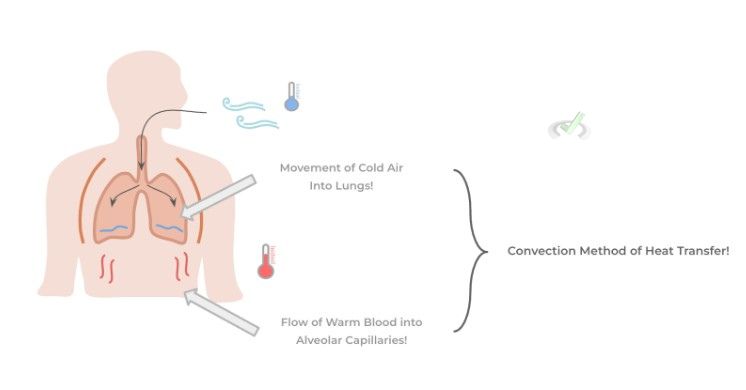
IV. Wrap Up/Key Terms
Let’s take this time to wrap up & concisely summarize what we covered above in the article!
A. Immune Defense Role of the Respiratory System
The respiratory system actually functions as a primary innate immune defense due to the structures and cells which line the respiratory tract!
Within the vestibule of the nasal cavity are nasal hairs, specifically called vibrissae, which can filter out respiratory particles possibly containing pathogens such as bacteria or viruses.
Cilia of the pseudostratified respiratory epithelium and the associated Goblet cells form the mucociliary elevator! The Goblet cells produce mucus which entraps pathogens while the cilia beat and move the mucus in a pulsatile fashion in order to move the mucus upwards in order to be coughed out!
B. Thermoregulation
The respiratory system also aids in the regulation of body temperature — in states of increased body temperature, we breathe in cool air which traverses down towards the alveolar sac.
The cool alveolar air and the warm blood flowing through the alveolar capillaries participate in convection mediated heat diffusion where heat is lost by the blood as it diffuses into the cooler alveolar hair! Now, the overall body temperature decreases because of the loss of heat flowing within the blood.
V. Practice
Take a look at these practice questions to see and solidify your understanding!
Sample Practice Question 1
Kartagener syndrome is a genetic disorder characterized by the presence of dysfunctional cilia due to various mutations. Which of the following structures would most likely be affected as a result of this disease?
A. Nasal Hairs (Vibrissae)
B. Goblet Cells
C. Respiratory Simple Squamous Epithelium
D. Respiratory Pseudostratified Epithelium
Ans. D
Recall that much of the underlying respiratory epithelium is composed of ciliated pseudostratified epithelium! As such, this condition would prevent the formation of functioning cilia which would result in a dysfunctional mucociliary elevator!
Sample Practice Question 2
Which of the following would be considered the first point of immune defense of the respiratory tract?
A. Neutrophils
B. Nasal Hairs (Vibrissae)
C. T Cells
D. Mucociliary Elevator
Ans. B
The vestibule of the nasal cavity has an abundant amount of nasal hairs which work to filter out larger respiratory particles! This is essentially the first point of respiratory immune defense because this is the first passage of entry in order to traverse deeper into the respiratory tract!







 To help you achieve your goal MCAT score, we take turns hosting these
To help you achieve your goal MCAT score, we take turns hosting these 





















 reviews on TrustPilot
reviews on TrustPilot